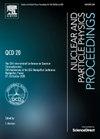Renormalization group improvement and QCD sum rules
Q4 Physics and Astronomy
Nuclear and Particle Physics Proceedings
Pub Date : 2024-06-01
DOI:10.1016/j.nuclphysbps.2023.11.004
引用次数: 0
Abstract
We summarize the results obtained for the quark masses (u,d,s,c, and b) in Refs. [1], [2] and strong coupling () using renormalization group (RG) improvement of the theoretical expressions and experimental inputs that enter in the QCD sum rules. We obtain , , and using Borel Laplace sum rules for the divergence of the axial vector currents. The relativistic sum rules for the moments of the heavy quark currents lead to the determination of , and .
重正化群改进与 QCD 和则
我们总结了参考文献[1]、[2]中关于夸克质量(u、d、s、c 和 b)和强耦合(αs)的结果,并使用重正化群(RG)改进了 QCD 和则中的理论表达式和实验输入。我们利用博雷尔拉普拉斯轴向矢量电流发散和规则,得到了mu(2GeV)=2.00-0.40+0.33MeV、md(2GeV)=4.21-0.45+0.48MeV和ms(2GeV)=104.34-4.24+4.32MeV。重夸克电流矩的相对论和规则导致测定了αs(MZ)=0.1171(7)、m‾c=1281.1(3.8)MeV和m‾b=4174.3(9.5)MeV。
本文章由计算机程序翻译,如有差异,请以英文原文为准。
求助全文
约1分钟内获得全文
求助全文
来源期刊

Nuclear and Particle Physics Proceedings
Physics and Astronomy-Nuclear and High Energy Physics
CiteScore
0.40
自引率
0.00%
发文量
0
期刊介绍:
Nuclear and Particle Physics Proceedings is the premier publication outlet for the proceedings of key conferences on nuclear and high-energy physics and related areas. The series covers both large international conferences and topical meetings. The newest discoveries and the latest developments, reported at carefully selected meetings, are published covering experimental as well as theoretical particle physics, nuclear and hadronic physics, cosmology, astrophysics and gravitation, field theory and statistical systems, and physical mathematics.
 求助内容:
求助内容: 应助结果提醒方式:
应助结果提醒方式:


